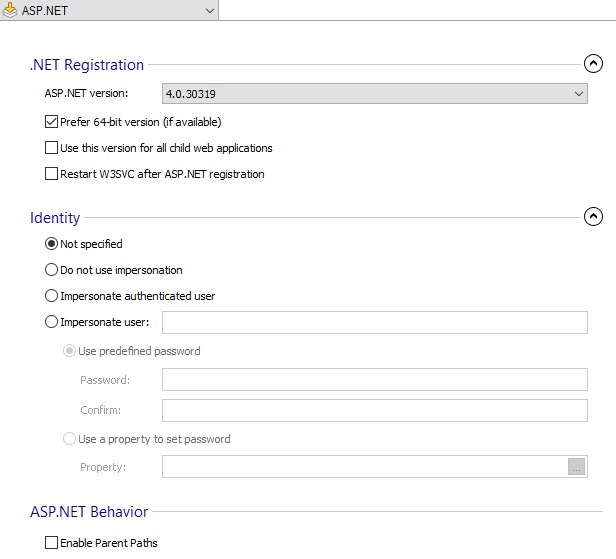
Optimizing Your Web App with Advanced Techniques in ASP.NET Settings

Optimizing Your Web App with Advanced Techniques in ASP.NET Settings
Table of Contents
- Introduction
- Registration
- Using Advanced Installer
- GUI
- Working with Projects
- Installer Project
* Product Information
* Resources
* Package Definition
* Requirements
* User Interface
* System Changes
* Server
* Internet Information Services Page”)
* IIS Server
* Global Settings
* Website Settings
* Physical Path Credentials Dialog
* Web Site Bindings/SSL Settings
* Virtual Directory Settings
* ASP.NET Settings
* Access Flags
* Authentication
* Default Document
* Website Performance
* FTP Access
* FastCGI Settings
* ISAPI Filters
* MIME Types
* Application Mapping
* HTTP Response Headers
* Machine Key
* HTTP Error Handling
* .NET Error Handling
* Custom Properties
* Application Pools
* Web Deploy Packages
* Legacy Options
* IIS Browse
* ODBC
* SQL Databases
* SharePoint Page
* Silverlight Page
* Custom Behavior - Patch Project
- Merge Module Project
- Updates Configuration Project
- Windows Store App Project
- Modification Package Project
- Optional Package Project
- Windows Mobile CAB Projects
- Visual Studio Extension Project
- Software Installer Wizards - Advanced Installer
- Visual Studio integration
- Alternative to AdminStudio/Wise
- Replace Wise
- Migrating from Visual Studio Installer
- Keyboard Shortcuts
- Shell Integration
- Command Line
- Advanced Installer PowerShell Automation Interfaces
- Features and Functionality
- Tutorials
- Samples
- How-tos
- FAQs
- Windows Installer
- Deployment Technologies
- IT Pro
- MSIX
- Video Tutorials
- Advanced Installer Blog
- Table of Contents
Disclaimer: This post includes affiliate links
If you click on a link and make a purchase, I may receive a commission at no extra cost to you.
ASP.NET Settings

.NET Registration
When multiple .NET Framework versions are executing side-by-side on a single computer, the ASP.NET ISAPI version mapped to an ASP.NET application determines which common language run-time (CLR) version is used for the application. The ASP.NET IIS Registration Tool (Aspnet_regiis.exe) is used by Advanced Installer to easily update the script maps for an ASP.NET application to point to the ASP.NET ISAPI version that you configure.
ASP.NET Version
Configure the version of ASP.NET that your web application is using.
- no ASP.NET registration is made; - 2.0.50727 - register your application with .NET 2.0, 3.0 or 3.5;
- 4.0.30319 - register your application with .NET 4.0;
Prefer 64-bit version (if available)
On 64-bit systems, if both a 32-bit and a 64-bit version of the same .NET Framework are found, register with the 64-bit version.
Use this version for all child web applications
Installs the script map that points to the ASP.NET ISAPI version you configure to all ASP.NET applications at the specified application root path and its subdirectories.
Restart W3SVC after ASP.NET registration
Triggers a restart of the World Wide Web Publishing Service after installing or updating ASP.NET script maps. When you use this option, all application pools are_recycled_.
For IIS 7 or newer, the ASP.NET version to be used by your web application must be set in the configuration of the application pool to which it belongs .
Identity
Use ASP.NET impersonation when you want to run your ASP.NET application under a security context different from the default security context for ASP.NET application.
Not specified
This default option assures every ASP.NET impersonation option is inherited from the server.
Do not use impersonation
Disables ASP.NET impersonation.
Impersonate authenticated user
With this impersonation option, your ASP.NET application will run under the security context of the user authenticated by IIS .
Impersonate user
Choosing this impersonation option will run the application under an arbitrary account with whatever security context was set up for that account. This is a Formatted Type field and it can be edited using Smart Edit Control .
Use predefined password - Specify a predefined hard coded password.
Use a property to set password - Reference a property for the password. Use the [… ] button to select an existing property or to create a new one.
ASP Behavior
Use this section to manage ASP (Classic) configuration settings.
Enable Parent Paths
This option allows you to use “..” in calls to functions such as MapPath by allowing paths relative to the current directory to use the ..\ notation. Enabling this option may be a security risk because an include path can access critical or confidential files outside the root directory of the application.
Did you find this page useful?
Please give it a rating:
Thanks!
Report a problem on this page
Information is incorrect or missing
Information is unclear or confusing
Something else
Can you tell us what’s wrong?
Send message
Also read:
- [New] In 2024, Cutting Costs with Low-Priced VR Technology (China)
- [New] In 2024, Ranking the Leading Free SRT Translation Tools
- [Updated] Tiny Screenplay Scheme
- Banish Cod Warzone Glitch Code 6328 - Expert Fixes and Strategies Gamers
- Captivating Cold Ideal Snowy Scenes to Brighten Videos for 2024
- Comment Désactiver OneDrive Sur Windows 11 : Une Solution Simple Et Efficace
- Effortless Guide for Downloading iPhone Footage Onto a Windows 11 System
- Effortless Windows 11 System Restore: Save Your Files and Bounce Back
- Guida Completa Alla Clonazione Di Un'unità SSD Con Software PNY Usando AOMEI Backupper Su Windows
- In 2024, Android to Apple How To Transfer Photos From Samsung Galaxy F15 5G to iPad Easily | Dr.fone
- In 2024, Thriving in Digital Discussions Essential Strategies for Proficient ZOOM Chats
- In-Depth Hardware Analysis with Tom's Technology Review
- Quick Fixes to Get the Scroll Wheel Working Again on Your Logitech Mouse
- Revolutionizing Your Campaigns: The Updated Foundations of Email Marketing in 2010 | Part Two, Featuring Massmail Insights
- Schnellbehebung: Wie Sie Die Geschwindigkeit Ihrer Windows 10 Festplatte Optimieren
- Why Choose a Dedicated Responsive Mailing System? Unveiling the Top 3 Superiorities to Web Services | MassMail Expertise
- Windows 10をSSDに転送する - 手っ取り早いクローンレス方法
- Title: Optimizing Your Web App with Advanced Techniques in ASP.NET Settings
- Author: Joseph
- Created at : 2024-11-15 00:29:42
- Updated at : 2024-11-21 17:27:24
- Link: https://fox-sure.techidaily.com/optimizing-your-web-app-with-advanced-techniques-in-aspnet-settings/
- License: This work is licensed under CC BY-NC-SA 4.0.